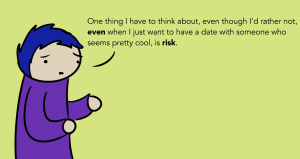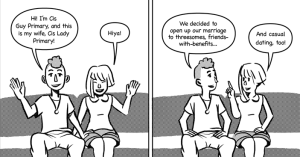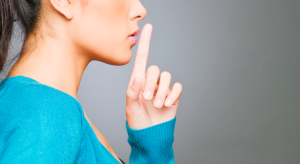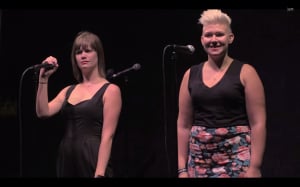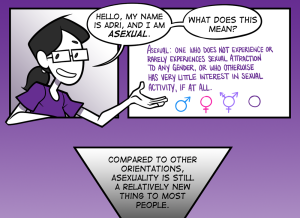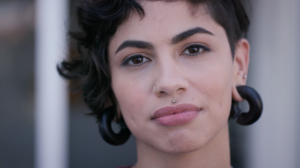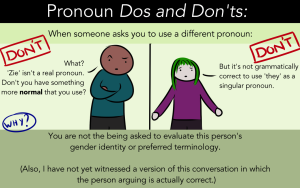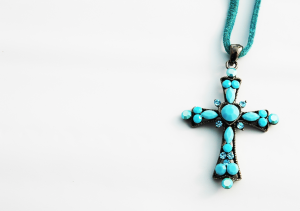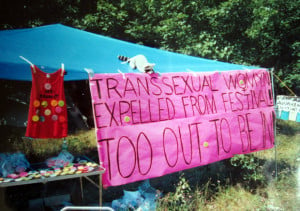
Source: Trans Advocate
Imagine a sun-soaked, leafy haven filled with women from all parts of the country. For a few short days, loud music reverberates through your bones, jaunts through pine woods are frequent, and at night, women connect on all sorts of levels—from everything political to everything personal.
A feminist utopia.
We all want safe spaces to heal, relax, and connect with our peers. And so many of us need closed spaces where we don’t have to deal with privileged people mansplaining our oppression. So what’s the matter with women’s spaces?
Well, it depends which women we’re talking about. Most of the time, “women’s space” is code for “cis women’s space,” which is a problem.
Women’s spaces that exclude trans women, either explicitly or implicitly, are saying that trans women aren’t really women.
At the same time, people who aren’t women are often welcomed, even celebrated. In practice, “women’s communities” often means “assigned-female-at-birth (AFAB) communities.” This means that transgender men and AFAB non-binary people are given access to these spaces while transgender women and assigned male at birth (AMAB) non-binary people can’t come near.
In effect, this means that some men are allowed in these “women’s spaces,” while some women are not – and nobody is acknowledging the existence or place of non-binary people.
The Michigan Womyn’s Music Festival, or Michfest, is one of those spaces that explicitly and violently excludes transgender women. For many years, activists have camped outside the festival protesting this exclusion.
After decades of activism, Michfest’s leaders never budged. However, increased boycotts meant that Michfest would either have to open its doors to all women, or close.
No one was surprised when it chose to close down rather than finally take a step towards equality.
Although many people who enjoyed Michfest are sad to see this space go, this is a good thing for feminism in general. Many people aren’t aware of the violent history of Michfest. A lot of folks have enjoyed Michfest without understanding the harm it has done.
And it doesn’t have to be overtly violent to cause harm to transgender women and AMAB non-binary people.
Transmisogyny is the intersection of transphobia and sexism that all AMAB trans people experience – and it isn’t just at Michfest. Less obvious forms of it exist in a lot of feminist spaces, and it’s hurting our movements.
Justin Kilian and Adrian Ballou are two activists who are pushing back against this discrimination. Adrian is an AFAB non-binary alum of Smith College, a school that (until recently) excluded transgender women, and Justin is a trans woman who worked intensively on the campaign that made Smith inclusive of all women.
After we cover some of the history behind Michfest and transmisogyny in “women’s spaces,” we’re going to learn directly from them on their thoughts about Michfest closing, transmisogyny in feminist spaces, and how we can make a stronger feminism for everyone.
When Feminism Spreads Hate
Michfest’s leaders are trans-exclusionary radical feminists, or TERFs. Trans exclusionary radical feminism’s mission is keeping feminism safe for “real” women – ie, cis women.
According to TERFs, trans people don’t exist. We are, simply, our genitalia – participating in “the savage mutilation of transgenderism” (as Sheila Jeffreys likes to call it).
Under this ideology, assigned-male-at-birth (AMAB) trans people are men, “agents of the patriarchy” in sheep’s clothing.
In a 1977 letter to the Olivia Records Collective threatening all the women working with trans woman Sandy Stone, TERFs – including leaders of Michfest – wrote, “We do not believe that a man without a penis is a woman any more than we would accept a white woman with dyed skin as a Black woman.” (No, being transgender and cultural appropriation are not the same thing.)
Janice Raymond is the mother of trans-exclusionary radical feminism and “womyn-born-womyn” policies and spaces. Through her hatred of trans women (and her academic attempts to prove they don’t exist), Raymond has created most of the challenges that trans healthcare advocates face today.
TERFs regularly out trans women, harass them and their employers, and send threatening messages to trans women (usually with the intention of pushing them to suicide).
Their violence doesn’t stop there. At a gay pride parade, Sylvia Rivera, a trans Latina stonewall veteran, was heckled and beaten off of the stage by cis lesbians. TERFs have even tried to kill trans women, as when they had snipers threaten trans activist Sandy Stone.
Cis lesbians and others who advocate for trans women aren’t safe either. TERFs intimidate anyone “betraying the cause” and beat them up too.
But It’s Not Just TERFs
Not everyone is as extreme as TERFs, but trans women are not only being killed through active hate. When you think about it, “I don’t want to kill you” is actually a pretty low bar for social interaction.
And not wanting to kill someone – or even saying you want to include them – is a far cry from actually making them feel safe and affirmed.
TERFdom is not in the past and it’s not only about Michfest. Transmisogyny is everywhere – including other feminist spaces. Although some people perpetuate transmisogyny on purpose, many feminists subconsciously do it too.
One of the easiest ways for folks to do this is by creating “women only” spaces that are openly or implicitly excluding trans women and AMAB non-binary people.
There are a lot of assigned female at birth (AFAB) feminists who police the identities of AMAB people – sometimes completely unintentionally.
You could be doing this too. It doesn’t mean that you’re a TERF, but you don’t have to engage in such an ideology to participate in transmisogyny.
Although TERFs are a hate group, transmisogyny in other feminist spaces can also have very negative effects, including (but not limited to) isolation, identity-based trauma, and gaslighting.
In this interview, Justin and Adrian will discuss some of the more subtle aspects of transmisogyny in feminist spaces. We’ll examine in detail how “women only” spaces can be transmisogynistic, talk about how transmisogyny shows up in our own communities, think about how healing spaces can be more inclusive, and share some ideas about how to show up for all women.
We’re hoping you’ll come away with deeper understanding and more tools to make sure our feminisms are truly for everyone.
Let’s get started!
Why Are ‘Womyn-Born-Womyn’ Spaces Transmisogynistic?
Justin:
“Womyn-born-womyn” is basically a cissexist way of saying cis woman.
When people say that some women are born female, they’re saying that other women absolutely can’t be.
The idea that our womanhood is not as “natural” as cis women’s is already very popular. If we were not “born women,” then the gender binary dictates that we are strictly male. We are nothing more than wells of “phallic energy.”
This male image forced upon us assumes that our experiences can’t organically be one that any “natural” woman would share.
So when you assume that being raised as a girl is essential to womanhood, it is easy to deny the identities of women who have not experienced this. “Womyn-born-womyn” spaces only serve to bolster these assumptions.
There are many forms of gender-based privilege, but a certain kind of genitalia does not necessarily determine that. The “womyn-born-womyn” idea, and general TERF ideology, says that trans women somehow experience male privilege.
The truth is, trans women experience sexism just as regularly, and often times, more intensely, than cis women.
Adrian:
“Womyn-born-womyn” mentalities provide the “logic” for laws that deny trans women access to healthcare, housing, shelters, public accommodations like bathrooms and restaurants, education, and queer and trans spaces/funding.
This means that trans women and AMAB trans people are seen as more disposable in nearly every area. This creates environments where the suicides and murders of trans women of color accumulate in astronomical numbers – while very few notice or care.
Some people literally get away with murder on “trans panic” defenses – which are legal in 49 out of the 50 United States.
“Womyn-born-womyn” and AFAB-dominated spaces contribute to this oppression. We are killing our siblings via exclusion and unwitting transmisogyny, and it needs to stop.
What Forms Does Transmisogyny Take in Your Life?
Adrian:
Until earlier this year, my alma mater, Smith College, didn’t provide equal access for trans women. My being non-binary makes my relationship with women’s spaces complicated – but it doesn’t erase the privileges I have. As an AFAB non-binary person, Smith gave me safety from most violence for my orientation and gender.
I got a degree, never actually being a woman, while many women I know never could have been my classmates.
I also witness transmisogyny regularly in mostly-AFAB queer/trans spaces, which proves that it’s not just big bad cis dudes who are hating on trans women – we all, myself included, are transmisogynistic sometimes.
Even as many of us say things like “especially trans women of color” and quote Whipping Girl, too many of us talk about penises, trauma, and survivorship as if we’re the conservative bathroom police.
I know we usually have good intentions, but we often just don’t understand the level of solidarity that’s needed. I hear about social exclusion as if we need to make our potlucks more inclusive, but it’s deeper than that. It’s about survival.
It’s not simple, but on average, as an AFAB trans person, I am physically safer than my AMAB trans counterparts.
Yet in AFAB-dominated communities, we are leaving the most vulnerable members of our community out in the cold.
Justin:
A lot people in queer spaces hesitate skeptically when interacting with girls like me. In these moments of scrutiny, I feel like my place is one of controversy, not community.
Whether people realize it or not, they are perceiving me as an imposter.
Most queer people treat me like I’ve done something wrong, when I am just trying to make it through the day, never mind dealing with transmisogyny. When I do try to call out such behavior, I’m met with responses that can be summed up in two sentences: “TERFs are a tiny sect of radical feminism. A majority of radical feminists are not like that.”
Then why has trans exclusionary radical feminism been so influential in shaping the landscape of transmisogyny today? Because transmisogyny is everywhere, even in “progressive” feminism.
When we say that something is wrong, the proper response is not to scapegoat TERFs.
Doing that sends the message to us that you care more about the reputation of radical feminism than you do the actual lives of trans women.
It’s this continued displacement of trans women that I experience on a day-to-day basis. And it adds up. After all, when we’ve been exiled to no-woman’s-land, it’s quite easy for us to disappear entirely.
Are ‘Womyn-Born-Womyn’ Spaces Truly Healing? How Can We Make More Feminist Spaces Healing for Trans Women?
Adrian:
A lot of my AFAB queer and/or trans community members are expressing nostalgia for Michfest. They say it’s “problematic,” yet healing. They say we owe a lot to the Michfest attendees who came before us and paved the way.
Many say Michfest is a “safe space,” but there is nothing inherently unsafe about trans women.
Let’s be clear: Michfest does have a deep influence and legacy – but not a positive one. Michfest never was a feminist event worth having.
When we are part of a community that advertises empowerment or healing to some women but not to others, we are not actually empowering or healing anyone.
Freedom gained by oppressing others is not a freedom worth having at all.
Everyone should have access to resources to fight gender-based discrimination. Everyone should have access to spaces where they can be physically safe and where they can heal.
Justin:
Many healing spaces are not equipped to meet the needs of trans women, but they have potential. Like anyone else recovering from oppression-based trauma, we have specific needs.
First of all, ask us where we’re at.
Today, we might need time with our trans sisters. Tomorrow, we might need to be in community with everybody. Our needs, like yours, can be constantly shifting.
The way you approach us is also important. There are feminists who engage with trans women out of the goodness of their hearts, or to seem more radical. There is some sort of cred to be had by saying you know us or are our friends/lovers.
So I’ll say it once: We don’t want your help unless that help is borne out of solidarity. We are not gratitude machines that release congratulations when you reach peak savior.
In the words of Lilla Watson, “If you have come to help me, you are wasting your time. If you have come because your liberation is bound up with mine, then let us work together.”
We are trying to survive, just as you are, although the way we do it will certainly be different than yours. Know this when you approach us.
Be real about where you’re coming from, and we’ll be real with you. Let’s work towards building a better reality for the both of us, together.
What Are Some Ways to Confront Transmisogyny in AFAB and Feminist Spaces?
Justin:
Introspection, education, and calling out.
If you are uncomfortable around a trans woman, consider the reasons why. Know that you too have been taught transmisogyny all your life.
Educate yourself.
Read up on some of the material that trans women and AMAB non-binary people have written about their experiences. Believe them. We are not making this up.
Combating transmisogyny also means being intersectional. That means educating yourself about the unique ways that trans women of color, trans women with disabilities, trans women of different faiths, undocumented trans women, etc., are oppressed. (These single stories do not reflect the universal experiences of trans women with multiple oppressed identities.)
Finally, we need you to actively challenge transmisogyny, especially in queer and/or feminist spaces.
Fight for equity on institutional and interpersonal levels.
I’ll admit – it will not make you popular, but it is the right thing to do. And for the sake of my sisters who are dying, it is the necessary thing to do.
Adrian:
AFAB trans and queer folks, I care about you, and I care about our communities. Which is why I want us to fight transmisogyny, and for our spaces to hold us all.
The absences of trans women from our community—they hurt trans women exponentially more, but they also hurt us.
Yet so many of us choose to remain in our “comfort zones,” comfort zones which are empty of people who experience the roots of both sexism and transphobia: trans women.
Let’s do some deep self- and community- examination. It’s time to ask ourselves some tough questions.
Who’s missing? Why? How have we been involved, institutionally and interpersonally? What can we do to provide AMAB trans people access to resources that can keep them safe, alive, successful, and happy?
That’s what I want for all of us.
***
When you take the word “trans” out of it, what self-respecting feminist would disagree with the statement, “Supporting policies that kill women is not feminist?”
Let’s be a part of the feminism that lets us all grow and thrive. Let’s celebrate the feminism that truly works towards justice. Let’s celebrate all the people who are working – with and without recognition, with and without success—to end transmisogyny.
Because the end of even one hateful festival is getting us a little closer to that feminism. It’s lives longer lived, with more opportunity.
And that’s what feminism is about.
[do_widget id=’text-101′]
Adrian Ballou is a Contributing Writer for Everyday Feminism. A genderqueer writer, artist, activist, and educator who does youth development work both inside and outside the classroom, they particularly enjoy writing and facilitating social justice education and youth organizing curriculum. To learn more about their consulting and speaking work, check them out here. In their free time, they cook lots of food, sing songs, make art, and practice their Spanish, Hindi, and Urdu. Read their articles here.
Justin Kilian is a queer, femme trans woman organizer who focuses on issues of transgender equity in the university system. She has served as a social justice educator for five years, using art as a means of facilitating conversations across difference as a seasoned actor, singer, dancer, writer, speaker, and director. She currently serves as director of Public Relations and Advocacy at Invisible No More, and has received recognition from organizations like PFLAG and Live Out Loud.
Search our 3000+ articles!
Read our articles about:
Our online racial justice training
Used by hundreds of universities, non-profits, and businesses.
Click to learn more
Most Read Articles
- « Previous
- 1
- …
- 30
- 31
- 32






